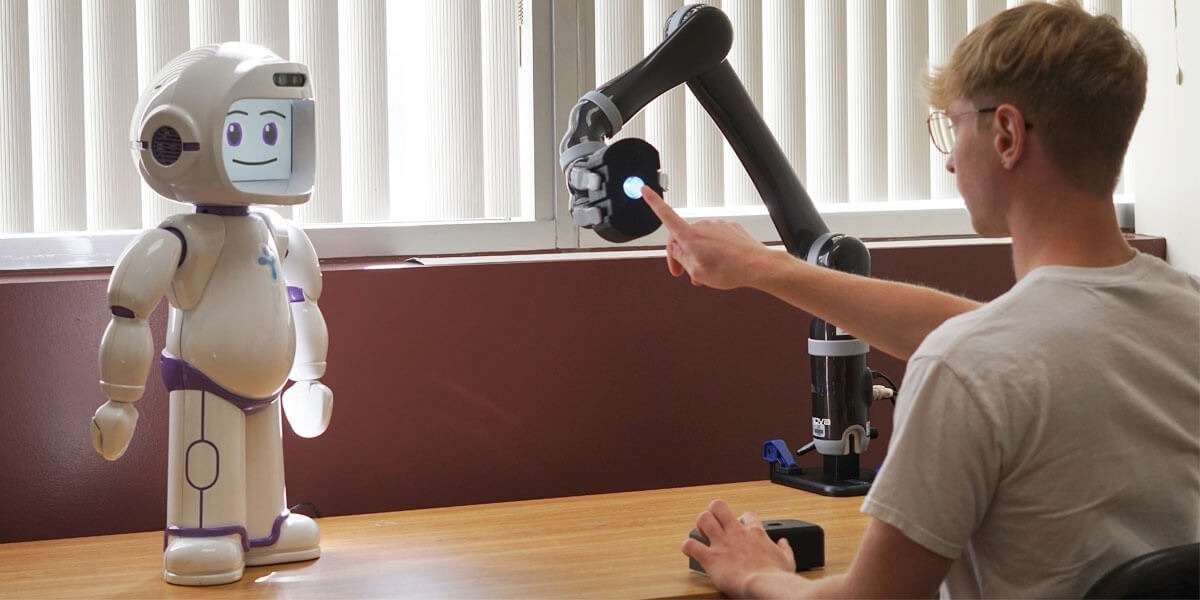
Lead author Nathan Dennler, a computer science doctoral student, with the robotic arm, which provides precise 3D spatial information, and a socially assistive robot, which gives instruction and motivation throughout the assessment. Image Credit/Nathan Dennler
Annually, over 15 million individuals worldwide experience a stroke, with three-quarters grappling with issues such as arm and hand impairment, weakness, and paralysis. Despite the common advice to “Use it or lose it,” overcoming the habit known as “arm nonuse” or “learned nonuse” can be a daunting task for stroke survivors, impacting their strength and injury prevention.
Assessing how much a patient utilizes their weaker arm outside clinical settings is challenging due to the observer's paradox, necessitating covert measurements for natural behavior.
Addressing this challenge, USC researchers have introduced an innovative robotic system designed to collect precise data on the spontaneous use of arms by stroke survivors.
The pioneering method, detailed in a paper published in the November 15 issue of Science Robotics, utilizes a robotic arm for 3D spatial information tracking. Employing machine learning techniques to analyze the data, the system generates an “arm nonuse” metric, offering clinicians a valuable tool to accurately evaluate a patient's rehabilitation progress.
Throughout the process, a socially assistive robot (SAR) provides instructions and encouragement to the individual.
Ultimately, we are trying to assess how much someone’s performance in physical therapy transfers into real life.
Nathan Dennler, Study Lead Author and Doctoral Student, Computer Science, Viterbi School of Engineering, University of South California
The study was a collaborative effort between researchers from USC’s Thomas Lord Department of Computer Science and the Division of Biokinesiology and Physical Therapy.
“This work brings together quantitative user-performance data collected using a robot arm, while also motivating the user to provide a representative performance thanks to a socially assistive robot. This novel combination can serve as a more accurate and more motivating process for stroke patient assessment,” stated Maja Matarić, study co-author and Chan Soon-Shiong Chair and Distinguished Professor of Computer Science, Neuroscience, and Pediatrics.
Additional contributors include Stefanos Nikolaidis, an Assistant Professor of computer science; Amelia Cain, an Assistant Professor of clinical physical therapy; Carolee J. Winstein, a Professor Emeritus and an Adjunct Professor in the Neuroscience Graduate Program; along with computer science students Erica De Guzmann and Claudia Chiu.
Mirroring Everyday Use
For this investigation, 14 participants, initially right-hand dominant before experiencing a stroke, were enlisted by the research team. Each participant positioned their hands on the device’s home position—a 3D-printed box equipped with touch sensors.
A socially assistive robot (SAR) explained the mechanics of the system and offered positive feedback, while a robot arm moved a button to various target locations in front of the participant (100 locations in total). The “reaching trial” commenced when the button illuminated, and the SAR prompted the participant to initiate movement.
During the initial phase, participants were guided to reach for the button using their naturally preferred hand, simulating everyday actions.
In the subsequent phase, they were specifically instructed to use the arm affected by the stroke, replicating actions performed in physiotherapy or clinical settings. Employing machine learning, the research team assessed three measurements—arm use probability, time to reach, and successful reach—to derive a metric for arm nonuse.
Detecting a noticeable disparity in performance between the two phases would indicate nonuse of the affected arm.
The participants have a time limit to reach the button, so even though they know they’re being tested, they still have to react quickly. This way, we’re measuring gut reaction to the light turning on—which hand will you use on the spot?
Nathan Dennler, Study Lead Author and Doctoral Student, Computer Science, Viterbi School of Engineering, University of South California
Safe and Easy to Use
Among chronic stroke survivors, the researchers noted significant variability in hand selection and the time taken to reach targets within the workspace.
The approach demonstrated consistency across multiple sessions, and participants evaluated it as user-friendly, earning above-average user experience scores. Additionally, all participants perceived the interaction as safe.
Suggestions for system enhancement through personalization were shared by participants, a facet the team intends to delve into in future studies.
This includes exploring the integration of additional behavioral data, such as facial expressions and diverse task types. Importantly, the researchers identified inter-participant differences in arm utilization, offering potential insights for healthcare professionals to more precisely monitor a patient’s stroke recovery.
For example, one participant whose right side was more affected by their stroke exhibited lower use of their right arm specifically in areas higher on their right side, but maintained a high probability of using their right arm for lower areas on the same side. Another participant exhibited more symmetric use but also compensated with their less-affected side slightly more often for higher-up points that were close to the mid-line.
Nathan Dennler, Study Lead Author and Doctoral Student, Computer Science, Viterbi School of Engineering, University of South California
As a physiotherapist, Cain highlighted that the technology tackles numerous challenges associated with conventional assessment methods.
Traditional approaches often necessitate the patient being unaware of the testing process, relying on the observer's judgment, which introduces a greater margin for error.
Cain added, “This type of technology could provide rich, objective information about a stroke survivor’s arm use to their rehabilitation therapist. The therapist could then integrate this information into their clinical decision-making process and better tailor their interventions to address the patient’s areas of weakness and build upon areas of strength.”
Journal Reference
Dennler, N., et al. (2023) A metric for characterizing the arm nonuse workspace in poststroke individuals using a robot arm. Science Robotics. doi.org/10.1126/scirobotics.adf7723.